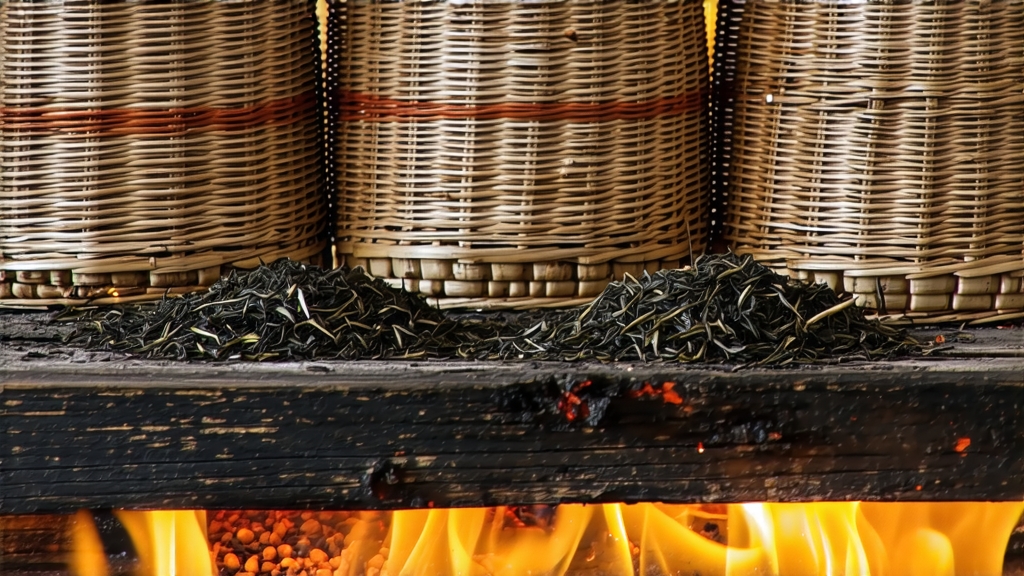
Long before Assam, Ceylon or Earl Grey were imagined, the first fully oxidised leaf that the West would later call “black tea” was born in the rugged Wuyi massif of northern Fujian. Locals named it Zheng Shan Xiao Zhong—“small leaf from the original mountain”—but 17th-century Dutch and British merchants, tasting its haunting pine perfume in the river port of Xingcun, phonetically rendered it Lapsang Souchong. A single sip carried across oceans on East-India clippers rewrote global palates and trade routes; three centuries later the same smoke-kissed liquor still divides connoisseurs between those who seek the campfire nostalgia of the export style and those who chase the subtler, pre-Qing “unsmoked” original. To understand Chinese red (hong) tea is therefore to begin with Lapsang Souchong, the primogenitor whose DNA of malt, honey and resin threads through every later cultivar.
Geography and cultivar
The protected Origin area is circumscribed by a 600 km² core inside the Wuyi National Park where Jurassic-era cliffs force humid maritime air upward into perpetual mist. Diurnal swings of 15 °C slow the growth of the indigenous Xiao Ye Zhong (small-leaf) tea tree, condensing amino acids and poly-phenols. Soils are lateritic, rich in iron and quartz; streams carry wild orchid and camphar fragrances that lodge in leaf memory. Outside this micro-zone farmers may produce “wai Shan” imitation, but only the 12 villages surrounding Tongmu Guan possess the minerality necessary for the sweet, cooling finish that sets authentic Lapsang apart.
Two families, two styles
- Traditional Smoke-dried (Song Xun): the leaf is withered over local Masson pine fires, oxidised in rolling bamboo drums, then hot-smoked a second time in wooden chambers above a pinewood hearth. Resin infuses the cell walls, creating notes of longan, pipe tobacco and wet bark.
- “Craft” or Unsmoked (Zheng Shan): developed in 2005 for the modern domestic market, the same leaf is withered naturally in heated rooms, baked over charcoal at 70 °C and finished at 45 °C to preserve ripe longan and caramel aromatics without smoke. Both styles share a chocolate-brown strip shape flecked golden tips, but the cup diverges into campfire versus dark honey.
Plucking calendar
Only the first flush after Qingming (early April) is picked—one bud plus two leaves, 3 cm standard—when spring mountain mists keep epidermal hairs closed, locking in high geraniol and linalool. A 6-hour window from pluck to wither prevents grassy notes; baskets are woven from fresh bamboo to avoid any off-odor.
Craft in five acts
Withering: leaves are laid on screens above pinewood embers (smoked style) or warm air ducts (unsmoked) for 8–10 h until 60 % moisture loss and grassy volatiles convert to floral aldehydes.
Rolling: 45 min of light pressure ruptures 30 % of cells, releasing catechins and polyphenol oxidase; strips tighten into glossy twists.
Oxidation: rolled leaf is piled 8 cm deep in cedar trays inside a 24 °C, 85 % RH “fermentation room”. Colour migrates from jade to copper in 2.5 h; master sniffers judge readiness when green apple gives way to ripe peach.
Firing: for smoked style, baskets are stacked above a pine-resin fire at 90 °C for 3 min, rested, then re-smoked twice more; total contact time 20 min. Unsmoked leaf enters an 80 °C charcoal oven for 2 h, reducing moisture to 7 %.
Sorting & Aging: stems and flakes are winnowed out; the tea is rested 30 days in linen-lined tins so pinewood phenols marry with theaflavins, softening astringency.
Chemical signature
Gas-chromatography reveals guaiacol, 4-methyl-guaiacol and eugenol as the key smoke markers (≈ 3 ppm) in traditional Lapsang, while the unsmoked version shows high maltol and furaneol, creating a natural cotton-candy sweetness. Both carry theaflavin-to